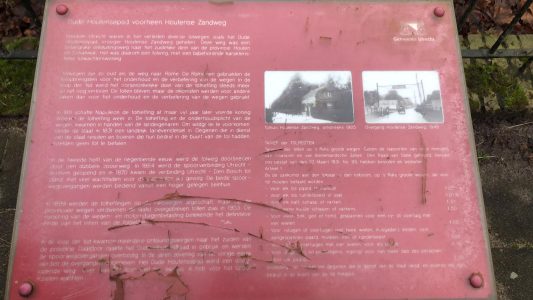Oude Houtensepad formerly known as Houtense Zandweg
Around Utrecht, there were various toll roads in the past, such as the Oude Houtensepad, formerly known as the Houtense Zandweg. This road was an important access road to the southern part of the province of Houten and Schalkwijk. It was therefore a toll road, with an accompanying characteristic tollkeeper's house.
Toll roads are as old as the road to Rome. The Romans used toll revenues for the maintenance and improvement of roads. Over time, the original purpose of toll collection was increasingly lost sight of. The tolls remained, but the revenue was used for other purposes than for the maintenance and improvement of roads.
In 1811, Napoleon abolished toll collection, but five years later, King William I reintroduced toll collection. The toll collection and maintenance obligation of the roads came into the hands of the landowners. To prevent uncontrolled growth, the state introduced a national tariff system in 1831. Those who traveled in the service of the state and farmers who had their business near the toll did not have to pay tolls.
In the second half of the nineteenth century, the toll road was cut through by a double railway. In 1864, the Utrecht-Arnhem railway connection was opened, and in 1870, the Utrecht-Den Bosch connection was established, resulting in long waiting times for passengers. The two level crossings were operated from a higher signal house.
In 1899, toll collection on national roads was abolished, but tolls on provincial roads did not disappear until 1953. The introduction of road and vehicle taxes meant the definitive end of toll collection.
Over time, several access roads were built to the south of the province, causing the Oude Houtensepad to fall into disuse, and the railway crossings became redundant. In the 1970s, the crossings were removed. The Oude Houtensepad became a dead-end road. [In the past], there was no excuse of “I had to wait for the train.”
Photo 1: Toll house Houtense Zandweg, around 1905
Photo 2: Crossing Houtense Zandweg, 1949
Tariff of Toll Rights
Rates of tolls on the kingdom's main roads. Having considered the reports of our ministers of finance and internal affairs and heard the Council of State, we have revised our decision of March 22, 1831, No. 95 and decide:
Article 1
Upon arrival at the toll post or toll boom on the kingdom's main roads, toll must be paid for:
- For each loose pair of mules or donkeys fl. ,05
- For each loose cattle or donkey fl. ,015
- For each calf, sheep, or pig fl. ,01
- For a herd of sheep or pigs fl. ,50
- For each goat, sheep or dog, harnessed to a carriage or vehicle with wheels fl. ,03
- For carriages or vehicles with two wheels, as well as sleds, harnessed to a horse, mule, donkey or cattle fl. ,50
- For […] vehicles with four wheels […] fl. 1,0
For government and post wagons equipped for no more than six persons, for each horse fl. 1,0
- Exemption from paying tolls for those who travel in the service of the state and farmers if they have their business near the toll.

